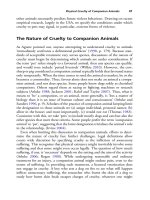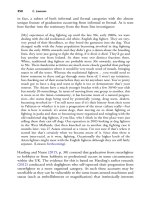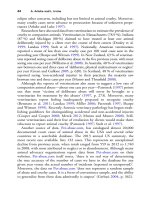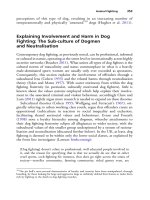The palgrave international handbook of a 182
Bạn đang xem bản rút gọn của tài liệu. Xem và tải ngay bản đầy đủ của tài liệu tại đây (25.26 KB, 1 trang )
174
E. Cudworth
memberships and the influence on national and international policy agendas may suggest possibilities for change.
Yet at this time of writing, two unsettling processes are at work. First,
concerns for animal welfare or environmental damage by livestock farming
appear insignificant in the face of development driven by multinational
corporations. Thus we see that the feedlot system continues to be exported
in beef farming, and intensive dairy farming pioneered in the US, where
cattle are kept permanently inside, in small stalls has been adopted in
European Union countries. Key targets for Western-based agricultural corporations in the near future however are parts of the Indian subcontinent and
Africa.
Second, a very small but notable development in some Western countries
(the Netherlands, Norway and Sweden) has been research and development
activity around ‘in vitro meat’. This involves the growth of muscle tissue in
laboratories with the intention of developing it for consumption as food.
Advocates, such as the ‘In Vitro Meat Consortium’ or the campaigning
group ‘New Harvest’, promote IV meat as a solution to the problems of
animal cruelty and environmental damage caused by meat production by
animal farming. IV meat is promoted as a social good, able to reduce
pollution, deforestation and greenhouse gas emissions associated with livestock production methods (Porcher 2014; Stephens 2010). Yet even the
economic assessments undertaken for the In Vitro Meat Consortium suggest
that this ‘meat’ will be intended for the high end niche market in Western
countries, priced above free range organic meat products (Stephens 2010). As
such, it seems an unlikely element of a solution to food poverty in developing
countries. In addition, the production techniques suggest that IV meat
production would place pressure on water resources, raising questions
about the environmentalist credentials of this new technology.
Both these future scenarios suggest that the production and consumption
of meat remains firmly within research, development and policy scenarios,
despite the increasing presence of critical voices.
Conclusion
This chapter has described and critiqued the historical processes and current
constitution of the global animal food industries involved with the breeding
and raising of some domesticate animals for food. The development of
animal breeding techniques and methods of animal raising which have
resulted in intensive production systems are currently spreading apace across









